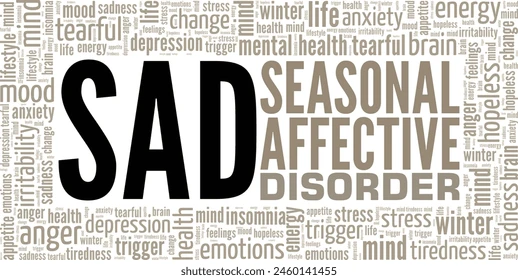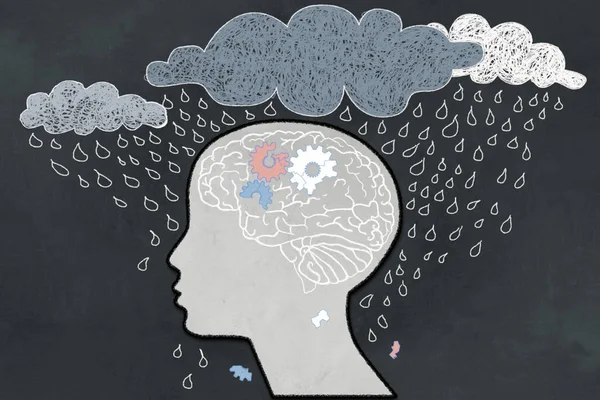Table of Contents

Introduction
Engaging Hook:
As the once vibrant leaves begin to wither and fall, as the days are swallowed by the encroaching darkness of winter, a palpable melancholy settles over many. For some, this is more than just a fleeting sense of nostalgia for the warm embrace of summer; it is the insidious onset of Seasonal Affective Disorder (SAD), a pervasive mental health condition that casts a pall over the coldest months. This blog post will serve as an in-depth exploration into the complexities of SAD, unraveling the tapestry of its symptoms, delving into the depths of its causes, and shedding light on the various treatment options available to those who find themselves grappling with the iron fist of winter depression.
Define Seasonal Affective Disorder (SAD):
Seasonal Affective Disorder (SAD) is a distinct and severe type of depression that follows a seasonal pattern, typically emerging during the autumn months as the days begin to shorten and the temperature drops. While it is not uncommon for individuals to experience a mild form of the “winter blues,” SAD is a clinical entity that significantly impairs the quality of life for those affected. It is essential to distinguish between the occasional bout of sadness that many feel as the seasons shift and the profound, persistent sadness that characterizes this condition.
Statistics and Prevalence:
According to extensive research, SAD affects approximately 5% of the population in the United States, with women bearing the brunt of this burden, being four times more likely to experience it than men. This condition tends to manifest during the tender years of young adulthood and shows a clear prevalence gradient, with those living closer to the poles being more susceptible due to the extended periods of darkness.
Purpose of the Blog:
The purpose of this blog is to illuminate the 10 most salient symptoms of SAD, offering readers a comprehensive understanding of the disorder. By doing so, we aim to arm individuals with the knowledge they need to identify potential warning signs within themselves or their loved ones and to encourage the pursuit of professional help when necessary.
- What is Seasonal Affective Disorder (SAD)?
Clinical Definition:
SAD is officially classified under the broader umbrella of Major Depressive Disorder with Seasonal Patterns within the Diagnostic and Statistical Manual of Mental Disorders, 5th Edition (DSM-5). It is distinguished by its predictable and recurring nature, typically commencing in the latter part of fall and dissipating with the arrival of spring or early summer.
Seasonal Patterns:
At the core of SAD lies the body’s response to the waning sunlight. As the days grow shorter, our biological clocks are disrupted, and the delicate balance of hormones that regulate our mood, sleep, and energy levels is thrown off-kilter. These seasonal fluctuations can have profound psychological and physiological effects, giving rise to the symptomatology of SAD.
Who is Affected?
While SAD can affect individuals across the gender spectrum, it disproportionately impacts women. Additionally, those who reside in regions with harsher winters, such as northern latitudes, are at an increased risk. The presence of SAD in one’s family history can also raise the likelihood of its development.
- Causes and Risk Factors of Seasonal Affective Disorder
Biological Factors:
The primary biological culprits behind SAD are serotonin, circadian rhythms, and melatonin. Reduced exposure to natural light leads to a decline in serotonin levels, a neurotransmitter critical to mood regulation. Concurrently, the disruption of our circadian rhythms—our internal body clock—can leave us feeling perpetually tired and desolate. The pineal gland, responding to the prolonged darkness, produces more melatonin, further contributing to the excessive sleepiness experienced by many with Seasonal Affective Disorder.
Genetic Predisposition:
A family history of depression or SAD can significantly increase one’s risk. Research suggests that the genetic underpinnings of mood regulation and the body’s response to light may play a role in the development of this disorder.
Environmental Factors:
The climate and geographic location are also significant factors in the incidence of SAD. Those living in areas with limited sunlight during winter months are more prone to developing the condition. Moreover, the lack of natural light in our modern, indoor lifestyles can exacerbate symptoms.
Risk Groups:
Certain segments of the population are more vulnerable to the effects of SAD. These include adolescents, who may be navigating the tumultuous waters of hormonal changes and identity formation, and individuals with pre-existing mental health conditions, such as depression or bipolar disorder. Chronic stress can also act as a catalyst for the onset of SAD.
Symptom 1: Persistent Low Mood
How It Manifests:
One of the most common symptoms of Seasonal Affective Disorder is a persistent, all-encompassing mood of sadness, emptiness, or hopelessness. These feelings can be so intense that they overshadow any moments of happiness, making even the most mundane tasks feel insurmountable.
Impact on Daily Life:
This pervasive sadness can have a devastating impact on personal relationships, work performance, and overall life satisfaction. It can lead to a cycle of isolation and despair that is difficult to break without professional intervention.
Why It Occurs in SAD:
The drop in serotonin levels is a key player in the persistent low mood experienced by Seasonal Affective Disorder sufferers. This chemical imbalance can lead to a distortion of one’s perception of reality, making it challenging to maintain a positive outlook.


Symptom 2: Fatigue and Low Energy
Unusual Tiredness:
Individuals with Seasonal Affective Disorder frequently report feeling drained and exhausted, regardless of the amount of sleep they get. This fatigue can be so overwhelming that it interferes with their ability to function normally.
Scientific Explanation:
The increased production of melatonin during the winter months is the primary driver behind this symptom. This hormone, which regulates our sleep-wake cycle, can lead to an overwhelming sense of sluggishness and lethargy.
Real-Life Examples:
A person with SAD may find it difficult to get out of bed in the morning, struggle to perform simple chores, or find themselves unable to concentrate on tasks that once came easily.
Symptom 3: Oversleeping
Hypersomnia Explained:
Sleeping for longer hours than usual is a hallmark of Seasonal Affective Disorder, often referred to as hypersomnia. Despite the excessive amounts of sleep, individuals often wake feeling unrefreshed and unrested.
The Vicious Cycle:
Oversleeping can create a negative feedback loop, exacerbating symptoms of fatigue and making it more challenging to maintain a consistent routine.
Biological Link:
The overproduction of melatonin, the sleep-inducing hormone, is a direct consequence of the extended periods of darkness. This can lead to a cycle of excessive sleep that perpetuates the symptoms of SAD.
Symptom 4: Cravings for Carbohydrates
Uncontrollable Urges:
People with Seasonal Affective Disorder frequently experience intense cravings for carbohydrate-rich foods, such as sugary snacks and starches.
Weight Gain:
These cravings often result in overeating, which can contribute to weight gain. This additional physical burden can compound feelings of low self-esteem and sadness.
Serotonin Connection:
Carbohydrates are known to temporarily boost serotonin levels, offering a brief respite from the gloom of SAD. However, this is a short-lived fix that can lead to a cycle of emotional eating and further weight gain.
Symptom 5: Difficulty Concentrating
Cognitive Fog:
Sufferers of SAD may find their ability to focus and process information significantly diminished. This can make even the most straightforward tasks feel like Herculean efforts.
Impacts on Life:
Difficulty concentrating can manifest in various ways, from struggling to perform well at work to having trouble with basic decision-making.
Underlying Causes:
The reduced exposure to sunlight and subsequent serotonin deficiency can impair cognitive function, making it difficult to think clearly.


Symptom 6: Social Withdrawal
Isolation Behavior:
SAD can lead individuals to withdraw from social interactions, which can exacerbate feelings of loneliness and sadness.
Psychological Explanation:
The low energy and mood associated with the disorder can make socializing feel like an insurmountable challenge rather than a source of joy and comfort.
Breaking the Isolation:
Identifying and addressing this symptom early is critical to prevent a downward spiral into further depression.
Symptom 7: Irritability and Agitation
Emotional Volatility:
Those with Seasonal Affective Disorder may become easily irritable and agitated, with a lower tolerance for stressors and a propensity for emotional outbursts.
Why It Happens:
The combination of fatigue, stress, and hormonal imbalances can make managing emotions a Herculean task.
Examples and Coping:
Common triggers include minor annoyances or disagreements with family members. Learning to recognize these triggers and implementing coping strategies can help mitigate the impact of irritability.
Symptom 8: Loss of Interest in Activities
Anhedonia Defined:
Anhedonia refers to the loss of interest or pleasure in activities that were once enjoyed.
Why Seasonal Affective Disorder Causes It:
The decline in dopamine levels, the neurotransmitter associated with pleasure and reward, is a direct consequence of reduced sunlight exposure during winter months.
Long-Term Impact:
This symptom can have a profound effect on relationships and personal satisfaction, as hobbies and social activities that once brought joy now hold no appeal.
Symptom 9: Feeling of Hopelessness or Worthlessness
Negative Self-Talk:
SAD sufferers may find themselves consumed by thoughts of despair, feeling like a burden to others or believing that they are worthless.
Escalation to Major Depression:
If left unaddressed, these feelings can deepen into a more severe depression.
Interventions:
Therapy and the support of a strong social network are invaluable in combating negative self-perceptions.
Symptom 10: Suicidal Thoughts
Warning Signs:
Persistent feelings of hopelessness, coupled with thoughts of suicide, are indicative of a critical mental health crisis.
Statistics:
Studies have shown an increased risk of suicide during the peak months of Seasonal Affective Disorder.
Immediate Steps:
It is crucial to seek help immediately, whether through a mental health professional or suicide prevention resources such as hotlines.
Diagnosing SAD: How to Identify It
Diagnostic Criteria:
Mental health practitioners rely on a combination of medical history, symptom presentation, and physical examinations to diagnose SAD accurately.
Self-Assessment Tools:
While online quizzes and symptom trackers can provide a starting point, they are not a substitute for a professional evaluation.
Importance of Professional Help:
Early diagnosis and treatment are vital to prevent the exacerbation of symptoms and improve the chances of effective management.
- Treatment Options for Seasonal Affective Disorder
Light Therapy:
How It Works:
Exposure to artificial sunlight via a light box mimics natural sunlight and can help to regulate the body’s production of serotonin.
Choosing a Device:
When considering light therapy, it is essential to select a device that is both affordable and effective, with features that cater to individual needs.
Psychotherapy:
Cognitive Behavioral Therapy (CBT):
CBT tailored to address seasonal depression can empower individuals with strategies to combat negative thoughts and behaviors.
Benefits:
This form of therapy equips patients with the tools they need to navigate the challenges of SAD and maintain their mental health year-round.
Medication:
Antidepressants:
Selective Serotonin Reuptake Inhibitors (SSRIs) are often prescribed to manage the symptoms of SAD by regulating mood.
Considerations:
While medication can provide relief, it is crucial to be aware of potential side effects and to always follow medical guidance.
Lifestyle Changes:
Diet and Exercise:
A balanced diet and regular exercise can significantly alleviate Seasonal Affective Disorder symptoms by promoting overall well-being and balancing mood.
Outdoor Time:
Spending time outside, even when the weather is not ideal, can boost mood and energy levels.
- Tips for Managing SAD Symptoms
Daily Routine Adjustments:
Sticking to a consistent sleep-wake schedule can help to regulate the body’s rhythms and improve mood.
Incorporating moments of mindfulness and self-care can provide a much-needed respite from the heaviness of SAD.
Mindfulness and Stress Reduction:
Techniques such as meditation, yoga, and journaling can be instrumental in managing stress and fostering a more positive outlook.
Building a Support System:
Connecting with friends, family, and support groups can provide the emotional sustenance needed to weather the storm of SAD.
Seasonal Preparations:
Plan ahead by scheduling activities and vacations that offer light exposure and social engagement.
Myths and Misconceptions About Seasonal Affective Disorder
Common Myths:
“Seasonal Affective Disorder is just a fancier term for the winter blues.”
“Women are the only ones who experience SAD.”
Debunking with Facts:
Armed with research and statistics, we aim to clarify the distinction between SAD and typical seasonal sadness and dispel the notion that it is a gender-specific condition.
- Seasonal Affective Disorder vs. Other Forms of Depression
Key Differences:
While other forms of depression can occur at any time, SAD is characterized by its seasonal onset and resolution.
Overlap with Other Disorders:
SAD shares symptomatic similarities with bipolar disorder and major depressive disorder, making accurate diagnosis essential.
The Importance of Raising Awareness
Breaking the Stigma:
By fostering open dialogues about Seasonal Affective Disorder, we can help to destigmatize mental health issues and encourage those in need to seek help.
Advocacy for Workplace and School Support:
Creating an environment that is understanding and accommodating of Seasonal Affective Disorder sufferers can make a world of difference in managing the condition.
Role of Social Media:
Utilizing social media platforms to share personal experiences and educational resources can help to build a community and raise awareness.


Conclusion
Recap of Key Points:
In summary, we have discussed the 10 primary symptoms of Seasonal Affective Disorder and their implications for those affected by the disorder.
Encouraging Action:
If you recognize these symptoms in yourself or someone you know, it is imperative to seek professional help.
Hopeful Message:
Remember, while the winter months may seem endless, with the right support and treatment, the darkness of Seasonal Affective Disorder can be lifted, and the warmth of spring can be found even in the coldest of seasons.
This blog post has been designed to serve as an extensive resource for understanding and coping with Seasonal Affective Disorder. The depth and breadth of information provided here are intended to offer insight, compassion, and practical advice to those affected by SAD. Whether you are navigating the disorder yourself or supporting a loved one, it is essential to remember that you are not alone and that help is available. With increased awareness and a multifaceted approach to treatment, it is possible to overcome the challenges posed by Seasonal Affective Disorder and find joy in every season.